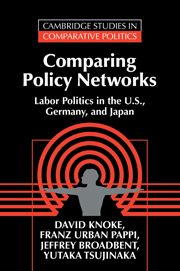Book contents
- Frontmatter
- Contents
- List of tables and figures
- Preface
- Acknowledgements
- 1 Policy-making in the Organizational State
- 2 Three Labor Policy Domains
- 3 Finding Domain Actors
- 4 Organizational Policy Interests
- 5 Policy Webs: Networks, Reputations, and Activities
- 6 Fighting Collectively: Action Sets and Events
- 7 Exchange Processes
- 8 Power Structures
- 9 Variations on a Theme of Organizational States
- Appendix 1 Legislative Procedures in Three Nations
- Appendix 2 Labor Policy Domain Organizations by Type
- Appendix 3 Cluster Analyses of Labor Policy Domain Issues
- Appendix 4 Labor Policy Domain Legislative Bills
- References
- Index
5 - Policy Webs: Networks, Reputations, and Activities
Published online by Cambridge University Press: 05 June 2012
- Frontmatter
- Contents
- List of tables and figures
- Preface
- Acknowledgements
- 1 Policy-making in the Organizational State
- 2 Three Labor Policy Domains
- 3 Finding Domain Actors
- 4 Organizational Policy Interests
- 5 Policy Webs: Networks, Reputations, and Activities
- 6 Fighting Collectively: Action Sets and Events
- 7 Exchange Processes
- 8 Power Structures
- 9 Variations on a Theme of Organizational States
- Appendix 1 Legislative Procedures in Three Nations
- Appendix 2 Labor Policy Domain Organizations by Type
- Appendix 3 Cluster Analyses of Labor Policy Domain Issues
- Appendix 4 Labor Policy Domain Legislative Bills
- References
- Index
Summary
Several analysts have proposed that state policy-making structures and processes are realizations of networks of resource exchanges among key actors (Heclo, 1978; Lehmbruch, 1984; Wilks and Wright, 1987; Laumann and Knoke, 1987; Broadbent, 1989b; Marin, 1991; Pappi, 1993). These relations are asymmetrical interactions that enable one social actor to affect another's behavior. Peter Marsden articulated a basic goal of such inquiries: “Of particular concern in establishing a link between structure and action is the question of how positions in social structure are transformed into disparities in power among actors” (1982: 201).
We conceptualize the policy networks of the U.S., German, and Japanese national labor policy domains as communication and political support relations among interested organizations that seek to influence public policy decisions. This chapter derives research expectations from the organizational state perspective and from the distinct cultural-historical institutions of the three nations. Next, we examine the global spatial structures of the communication and political support networks among core labor policy organizations, paying special attention to their center and periphery locations. Finally, we use structural equation methods to estimate the relationships of network centralities to organizational reputations and their legislative policy activities.
The struggle over collective decisions involves numerous interactions among organizational state participants, which permits their conceptualization and analysis as networks of exchange relations. Some organizations control scarce political resources that are highly valued by others. Resource-rich organizations typically exchange their resources for the cooperation and support of their exchange partners.
Information
- Type
- Chapter
- Information
- Comparing Policy NetworksLabor Politics in the U.S., Germany, and Japan, pp. 101 - 122Publisher: Cambridge University PressPrint publication year: 1996
Accessibility standard: Unknown
Why this information is here
This section outlines the accessibility features of this content - including support for screen readers, full keyboard navigation and high-contrast display options. This may not be relevant for you.Accessibility Information
- 1
- Cited by
